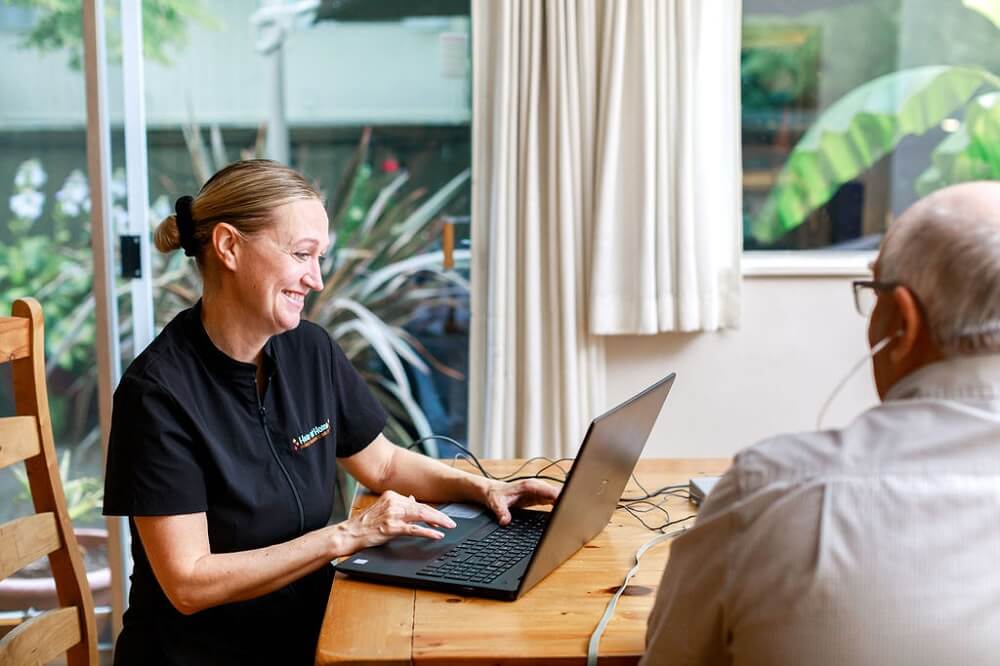Assistive Hearing Technology to Enhance Your Ability to Communicate
Hearing aids usually provide the best solution to help individuals with a hearing loss continue to go on with their daily life, but are there situations and circumstances when hearing aids aren’t enough?
Hear at Home recognizes that you might need something more than your hearing aids to enjoy a better hearing experience and richer quality of life.
In addition to fitting you with hearing aids and providing ongoing support, we provide assistive hearing technology to boost your ability to communicate in public and private settings by filling in the gaps for hearing aid users.
Assistive hearing technology can be broken down into two different types of devices: assistive listening devices (ALD) and assistive listening systems (ALS).
Assistive listening systems (ALS) help individuals with hearing challenges to hear better in places like theatres and lecture halls.

ALD Hearing Devices
ALD Hearing Devices
In general, ALD enables personal connections to audio sources for music and TV as well as visual, tactile alerting or alarms.
Amplified and Captioned Telephones
Specifically designed for people with a hearing loss, amplified devices allow you to turn up the volume in order to hear speech clearly whether you’re wearing your hearing aids or not, and they often come with amplified ringtones so you’ll never miss a call.
Captioned phones provide real-time captioning, like the closed captions you see on TV, and are particularly helpful for people with a severe to profound hearing loss.
Hearing Aid Compatible Phones and Telecoils
By law, telephone manufacturers, including iPhone and Android smartphones, must make phones compatible with hearing aids. Hearing aid compatible phones usually use either acoustic coupling, which amplifies sounds from the phone as well as any noise around you, or telecoil coupling, which requires a special feature that only picks up the phone conversation while blocking out background noise.
Some smartphone apps can serve as their own unique ALDs, like caption apps that provide text translation for speech.
ALDs for Televisions
Turning up the volume on your television isn’t always the best option for those around you and it can distort the sound, making it even more difficult to understand. Some television amplifiers work even without hearing aids, such as TV Ears® or a wireless headset with a personal volume control that plugs directly into your TV’s earphone socket.
Alerting Devices
Alerting devices typically rely on amplified sounds, visual cues and even vibrations to alert you to sounds in your environment. Some examples are vibrating alarm clocks and doorbell alerts that flash the lights to let you know someone is at your door as well as vibrating and flashing smoke and carbon monoxide detectors.
Listening Systems
Assistive Listening Systems for Public Settings
Assistive listening systems (ALSs) are used in public settings such as a theatre, airport, church or lecture hall.
There are three approved types of Assistive Listening Systems:
Hearing
Hearing Loops (aka induction loops or audio frequency induction loop systems). They include a system of copper wire placed within a room, theatre or counter connected via a special loop “driver” to a public address or sound system. Sound is wirelessly transmitted via small changes in the magnetic field and is directed into the telecoil of hearing aids, cochlear implants or telecoil receivers worn on the body.
FM or DM Systems
FM or DM Systems (radio frequency assistive listening systems). This type of ALS transmits wireless, low-power FM frequency radio transmissions from a sound system to FM receivers. Using the system requires a receiver and either headphones or a neckloop, but those with telecoil-equipped hearing aids or neckloops do not need headphones.
Infrared Systems (IR)
Infrared Systems (IR). Speech or sound transmission from a public address system uses invisible infrared light waves to send signals from a transmitter to an IR receiver. This technology requires line-of-sight and is interrupted in direct sunlight.
Listening Technology
Assistive Listening Technology Available from Hear at Home
-
 Amplified Telephones
Amplified Telephones
-
 Alerting Systems
Alerting Systems
-
 TV Listening Systems
TV Listening Systems
-
 Personal Amplifiers (Pocketalkers)
Personal Amplifiers (Pocketalkers)
-
 Remote Control Speakerphones For Independent Communications
Remote Control Speakerphones For Independent Communications
-
 FM Listening Systems
FM Listening Systems
-
 Infrared Systems
Infrared Systems
-
 Loop Systems
Loop Systems
-
 Vibrating Alarm Clocks And Watches
Vibrating Alarm Clocks And Watches
-
 Sound And Hearing Aid Conditioners
Sound And Hearing Aid Conditioners

Schedule a Mobile Hearing Care Appointment
If you’re homebound, struggle with mobility or are concerned about your safety in public, but need the advanced hearing healthcare a hearing specialist can provide, Hear at Home has you covered.
Just submit the adjacent form and one of our client care associates will contact you to schedule a mobile hearing care appointment.
"*" indicates required fields
Patient Stories
No matter what happens in the world, these people remain the centre of ours.
Blog
You Asked, We Answer
What are the Causes and Effects of Hidden Hearing Loss?
Maintain Hearing Health With These Daily Activities
Cerumen (Ear Wax) Buildup: Causes, Symptoms, and Removal
At Your Home, Or Ours.



